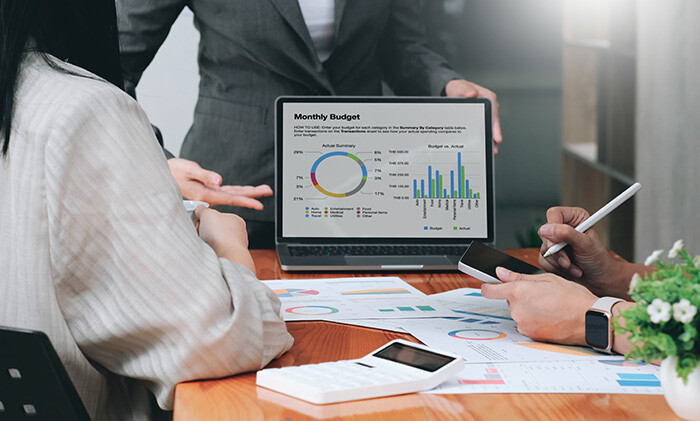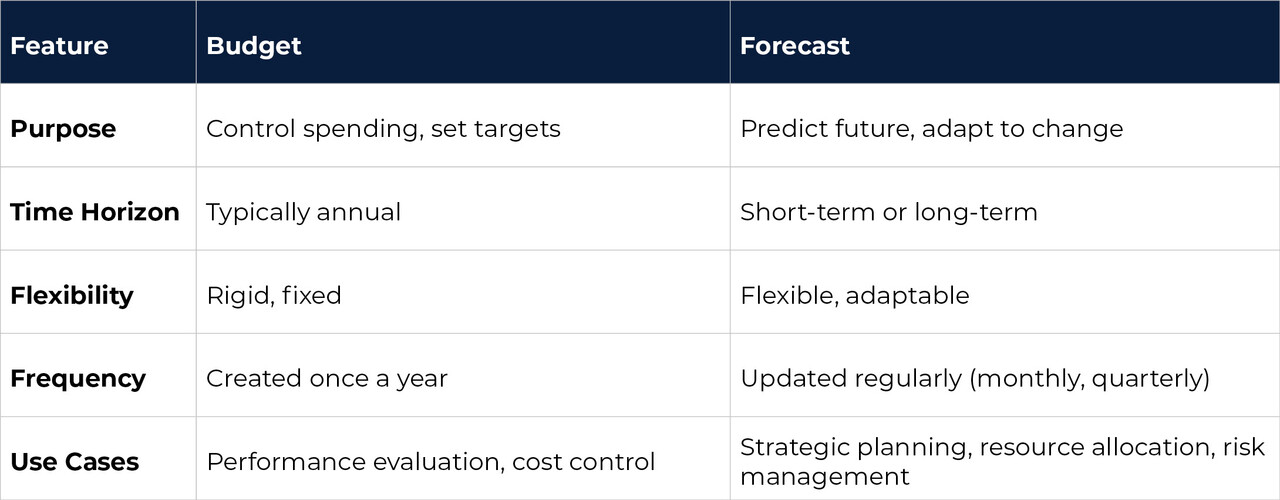Picture this: you’re running your small business, managing client meetings, managing staff, and trying to keep an eye on your finances. Then, an unexpected expense hits. Your supplier increases prices, or a piece of equipment breaks down. How prepared are you to handle these financial surprises? Understanding the budget vs forecast distinction could be your solution.
Many business owners find themselves in this exact situation because they haven’t properly implemented financial planning tools. This misunderstanding of the budget vs forecast relationship isn’t just a matter of terminology. It can significantly impact your business decisions and long-term financial health. Understanding the distinction between budgets vs forecasts is crucial for making informed business decisions and achieving sustainable growth.
In this guide, we’ll clarify what budgets and forecasts are, how they differ, and why your business needs both. We’ll provide practical steps to create effective financial plans.

The First Component Of Budget vs Forecast
Let’s start with the basics. What exactly is a budget? A budget is essentially a financial plan. It estimates your income and expenses over a specific period, usually a year. Think of it as a roadmap for your money. Its main purpose? To help you control spending, allocate your resources effectively, and set clear financial targets. Budgets are known for being fixed and somewhat rigid. You create them at the beginning of a period, and they serve as a benchmark for analysing your performance throughout that period.
How Budgets Help
So, how does a budget actually help you? First, it helps you manage your spending. By outlining how much money you should be spending in each area of your business, you can keep a close eye on where your money is going and avoid overspending. Second, it helps you set financial targets. Want to increase your profits by 10% this year? A budget can help you map out how to achieve that goal by setting specific targets for revenue and expenses.
How to Create an Effective Budget
Creating a budget might sound intimidating, but it doesn’t have to be. Here’s a step-by-step guide to get you started:
- Estimate Income: Start by estimating your income. Look at your past performance and consider any expected changes in sales. Be realistic.
- List All Expenses: Next, list all your expenses. This includes both fixed expenses, like rent and salaries, and variable expenses, such as materials and marketing costs. Don’t forget those smaller, often overlooked costs.
- Allocate Resources: Now, decide how much money to allocate to each area. This is where you make those tough decisions about where to prioritise spending.
- Monitor and Adjust: The job’s not over once the budget is created. You need to track your actual spending against your budget. If you notice any discrepancies, make the necessary adjustments. Things change, and your budget should reflect that.
Tools and Techniques
You’ve got options when it comes to creating your budget. Many people start with spreadsheets, like Excel or Google Sheets. They’re flexible and easy to use. However, as your business grows, you might want to consider accounting software. Many accounting programs include both budget vs forecast functionality. DASA Accountancy has expertise with relevant software, including TaxCalc and QBO, and can help you choose and implement the right solution for your business.
Sole Trader
Let’s imagine Sarah, a sole trader who runs a small online craft business. She wants to create a budget for the year. First, she estimates her income based on last year’s sales and anticipated growth. Then, she lists her expenses: website hosting, materials, marketing, and packaging. She allocates a certain amount to each category. Throughout the year, Sarah tracks her actual spending and adjusts her budget as needed. For example, if her marketing efforts are more successful than expected, she might increase her marketing budget. This helps her stay on track and make informed decisions.
Completing The Budget vs Forecast Equation
Now let’s talk about forecasts. A forecast is a bit different from a budget. It’s a prediction of your business’s future financial performance. Think of it as looking into a crystal ball, but with data to back it up. The purpose of a forecast is to anticipate what’s coming. Future revenues, expenses, and cash flow. Forecasts are flexible and dynamic. They’re designed to be adapted as conditions change.
How Forecasts Help
Forecasts are incredibly useful for predicting trends and anticipating events that could impact your business. For instance, a forecast can help you predict seasonal fluctuations in sales, identify potential cash flow shortages, or assess the financial impact of a new project. It’s about being proactive, not reactive.

How to Create an Accurate Forecast
Creating an accurate forecast requires a different approach than budgeting. Here’s a step-by-step process:
- Gather Historical Data: Start by gathering as much historical data as possible. This includes past sales figures, expenses, and market trends. The more data you have, the better your forecast will be.
- Identify Key Drivers: What are the factors that really influence your business? These are your key drivers. They might include seasonality, market conditions, or even changes in the economy. Understanding these drivers is crucial.
- Choose a Forecasting Method: There are several forecasting methods you can use. Here are a few:
- Simple Moving Average: This method uses the average of past data points to predict the future.
- Regression Analysis: This is a more sophisticated method that identifies relationships between variables to make predictions.
- Scenario Planning: This involves creating multiple forecasts based on different possible scenarios (best-case, worst-case, most likely).
- Monitor and Update: Just like with budgets, you need to monitor your forecast and update it regularly. As you get new information, adjust your forecast accordingly. This is an ongoing process.
Tools and Techniques
Several tools and techniques can help you create accurate forecasts. Forecasting software can automate much of the process. Statistical analysis is also incredibly useful. And don’t forget expert advice. DASA Accountancy offers advisory services to help you develop powerful and reliable forecasts. We can provide valuable insights and guidance.
Forecast Example: Limited Company
Let’s consider a limited company that manufactures and sells clothing. They want to forecast their cash flow needs for a new expansion project. First, they gather historical data on sales, expenses, and market trends. They identify key drivers, such as seasonality and economic conditions. They use scenario planning to create best-case, worst-case, and most likely forecasts. By doing this, they can anticipate potential cash flow shortages and secure funding in advance. This proactive approach helps them manage the project’s finances effectively.
Key Differences In The Budget vs Forecast Relationship
So we’ve covered what budgets and forecasts are individually. Now, let’s look at the key differences between them. It’s important to understand these distinctions to use them effectively.
Purpose
The primary purpose of a budget is to control spending and set financial targets. It’s about creating a plan and sticking to it. On the other hand, the purpose of a forecast is to predict future performance and adapt to changing circumstances. Understanding this fundamental budget vs forecast difference is crucial for financial planning. It’s about anticipating what’s coming and being prepared.
Time Horizon
Budgets usually have an annual time horizon. You create them once a year and use them to guide your financial decisions for the entire year. Forecasts, however, can be short-term (monthly, quarterly) or long-term (several years). You might create a short-term forecast to manage cash flow over the next few months or a long-term forecast to plan for expansion.
Flexibility
Budgets are relatively rigid and fixed. Once you create a budget, it’s not designed to be changed frequently. Forecasts, in contrast, are flexible and adaptable. You should update them regularly to reflect new information and changing conditions.
Frequency
As mentioned, budgets are generally created once a year. Forecasts, however, are updated regularly. Often monthly or quarterly. This regular updating makes sure that your financial plans remain relevant.
Use Cases
Budgets are primarily used for performance evaluation and cost control. They help you track your progress and identify areas where you’re overspending or underperforming. Forecasts are used for strategic planning, resource allocation, and risk management. They help you make informed decisions about the future of your business. And Business Planning is a service DASA Accountancy provides, which can help you with these strategic decisions.
Key Differences
To make these differences clear, here’s a table:

Integrating Budgets And Forecasts
How do I integrate budgets and forecasts? Using these tools together can really transform your financial decision-making.
How Budgets and Forecasts Work Together
When implementing a budget vs forecast system, start with your budget as the foundation. Budgets set the initial financial framework for your business. They provide the starting point. Forecasts then provide ongoing updates and adjustments to that framework. They keep you on track and help you respond to changes. The best approach is to compare your actual results to your budget and then use your forecasts to explain any differences. For example, if your sales are lower than budgeted, your forecast can help you understand why and what to expect in the future.
Benefits of Integration
Integrating budgets and forecasts offers some serious benefits:
- Improved Financial Control: You gain better control over your finances by combining the discipline of budgeting with the adaptability of forecasting.
- Better Resource Allocation: You can allocate resources more effectively by using forecasts to anticipate future needs and adjust your budget accordingly.
- Proactive Risk Management: Forecasts help you identify potential risks early, allowing you to take proactive steps to mitigate them.
- Enhanced Strategic Planning: Integrating budgets and forecasts provides a solid foundation for strategic Business Planning, enabling you to make more informed decisions about the long-term direction of your business.
Let’s look at a quick example. Imagine a small manufacturing company that sets an annual budget. Throughout the year, they update their sales forecast quarterly based on market trends and customer demand. If the forecast shows a potential dip in sales, they can adjust their production schedule and marketing budget to minimise the impact. This integration of budgets and forecasts helps them maintain profitability and achieve their financial goals.
DASA Accountancy’s Role
DASA Accountancy plays a crucial role in helping businesses effectively integrate budgets and forecasts. We provide expert guidance, support, and the right tools to streamline the process. Whether it’s setting up accounting software like TaxCalc or providing tax advice , we’re here to help. We can help you develop customised budgeting and forecasting models, analyse variances, and provide tax deduction strategies. We can also help you with HMRC compliance. You can also contact us for more information.
FAQs
What is the main difference between a budget and a forecast?
A budget is a financial plan that sets spending targets, while a forecast predicts future financial performance based on current trends and data.
How often should I update my budget?
Budgets are typically created annually but should be reviewed quarterly to ensure they remain relevant.
How frequently should I update my forecast?
Forecasts should be updated regularly, monthly or quarterly, or whenever significant changes occur in your business or market.
Can I use the same tools for budgeting and forecasting?
Yes, many accounting software programs like QBO and TaxCalc offer both budgeting and forecasting capabilities.
Do I need both a budget and a forecast for my small business?
Yes, even small businesses benefit from having both—budgets for control and targets, forecasts for adaptability and future planning.
Which comes first? The budget or the forecast?
Typically, you’d create a budget first as your financial framework, then use forecasts to adapt to changing conditions throughout the year.
How accurate should my forecast be?
Forecasts aren’t meant to be 100% accurate but should provide reasonable predictions based on available data and assumptions.
Can HMRC penalise me for not having a budget?
No, HMRC doesn’t require businesses to maintain budgets, but good financial planning helps ensure you meet tax obligations and identify deductions.
What’s the benefit of integrating budgets and forecasts?
Integration provides both financial control and adaptability, allowing you to maintain targets while responding effectively to changing circumstances.



